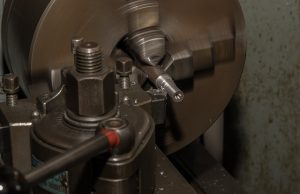
Turning and boring are two common machining processes used in the manufacturing industry. They both require the use of a machine to remove material from a workpiece. Whether a workpiece is made of metal or wood, it can be probably be reshaped with the help of turning or boring. While both of these machining processes are designed to remove material from workpieces, though, they aren’t necessarily the same.
What Is Turning?
Turning is a machining process that’s characterized by the use of a stationary, non-rotating cutting tool to remove material from the external surface of a workpiece. Although it can be performed by hand, turning is typically performed using a machine known as a lathe. The workpiece is secured to the lathe, after which it rotates while pressing against a cutting tool. As shown above, the cutting tool used in turning operations typically consists of a small blade. As the workpiece rotates against the blade, the cutting tool removes a uniform amount of material, thereby reducing the size and changing the shape of the workpiece.
There are several different subtypes of turning, including tapered, spherical and hard. However, they all require the use of a cutting tool to remove material from a workpiece. More specifically, they remove material from the external surface of a workpiece.
What Is Boring?
Boring is another machining process that, like turning, uses a stationary, non-rotating cutting tool to remove material from a workpiece. What’s the difference between turning and boring exactly? With turning, a cutting tool removes material from the external surface of a workpiece. With boring, a cutting tool removes material from the internal surface of a workpiece. In other words, boring essentially involves drilling holes in a workpiece using a cutting tool that resembles a drill bit.
While turning operations are performed almost exclusively with a lathe, boring operations are performed using either a lathe, a conventional milling machine or a boring milling machine.
In Conclusion
Turning and boring are similar machining processes in which a machine, such as a lathe or milling machine, uses a stationary cutting tool to remove material from a rotating workpiece. The difference between them lies in the area of the workpiece from which the material is removed. Turning is designed to remove material from the external surface of a workpiece, whereas boring is designed to remove material from the internal surface of a workpiece.
